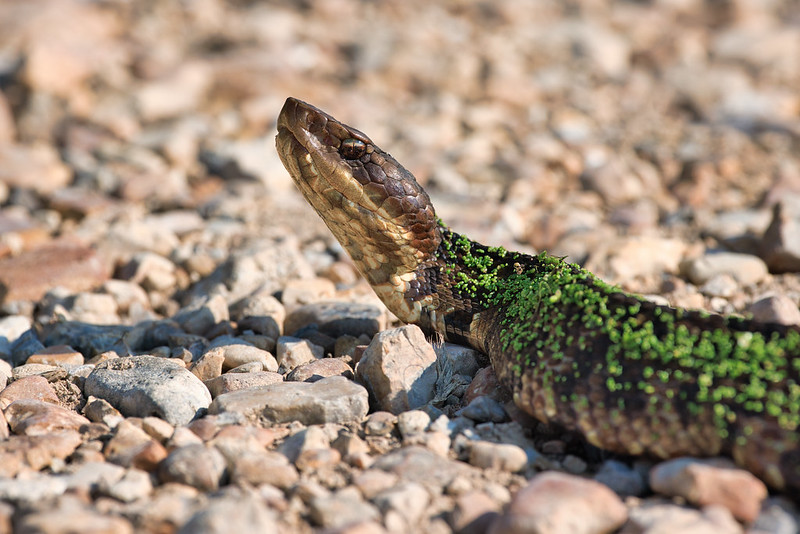As a passionate wildlife photographer, my journeys often lead me to breathtaking encounters with nature’s wonders. Last September, I shared a blog post featuring a striking image of a Water Moccasin covered in Duckweed. Today, on May 22, 2023, I found myself at Miner’s Cove, within the scenic Sequoyah National Wildlife Refuge in Oklahoma, where I came upon yet another incredible moment—a Water Moccasin adorned with Duckweed. Let me share with you the details of this encounter and answer a commonly asked question about how close I get to snakes while capturing these captivating images.

The Encounter:
As I parked my pickup truck near Miner’s Cove, a Water Moccasin began crossing the road right in front of me. Determined to capture this unique moment, I carefully exited my vehicle, making sure to maintain a safe distance. Armed with my trusty 500 mm telephoto lens, I observed the snake as it maneuvered its way through the gravel on the road.
Photographing from a Distance:
One of the most frequent questions I receive is about the proximity between myself and the snakes during these encounters. I want to emphasize that I prioritize the safety and well-being of both the wildlife and myself. Utilizing a long telephoto lens allows me to capture detailed images from a considerable distance, ensuring I don’t disturb the natural behavior of the snakes or risk any harm.
The Interaction:
While photographing the Water Moccasin, I couldn’t help but notice its instinctive reaction to my presence. Like many snakes, it raised its head off the ground, demonstrating its vigilance and awareness. Sensing the need to minimize disruption, I swiftly captured a few shots before allowing the snake to continue its journey undisturbed. My primary concern is to showcase the beauty and wonder of these creatures while ensuring their safety and conservation.
Preserving Wildlife:
One aspect that deeply troubles me is the intentional harm caused to snakes by some individuals. Snakes play a vital role in the ecosystem, maintaining the balance of various animal populations and controlling rodent populations. Deliberately running over snakes is not only cruel but also disrupts the ecological harmony of our natural surroundings. By actively helping snakes safely navigate across roads, we can contribute to the preservation of these mesmerizing creatures.
Conclusion:
Encountering a Water Moccasin adorned with Duckweed for the second time was an extraordinary experience. It reminds me of the countless wonders that nature has to offer and reinforces the importance of promoting wildlife conservation. As a wildlife photographer, I strive to capture the essence of these magnificent creatures while respecting their space and habitat. By using telephoto lenses and maintaining a safe distance, we can appreciate the beauty of wildlife without causing any harm. Let us embrace the diversity of our natural world and inspire others to cherish and protect it for generations to come.
Note: It is essential to exercise caution and respect when encountering wildlife, especially venomous snakes like Water Moccasins. If you encounter a snake in the wild, it is recommended to observe from a safe distance and never attempt to handle or provoke them.
Here is a post I made with some tips, “How Close Do I Get When Photographing Snakes”.
Equipment Used:
- Camera: Canon EOS R5
- Lens: Canon RF 100-500 mm F4.5-7.1 L IS USM
Technical Details:
- Location: Sequoyah National Wildlife Refuge (Oklahoma)
- Date and Time Taken: May 22, 2023 (09:04 A. M.)
- Aperture: f10
- Shutter speed: 1/1000
- ISO: 500 (Auto)
- Exp. Comp.: +0.3
- Focal Length: 500 mm
